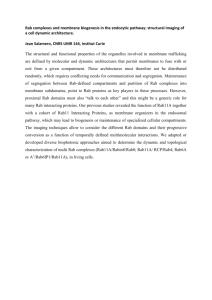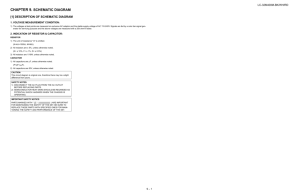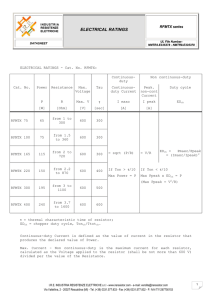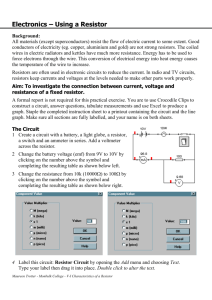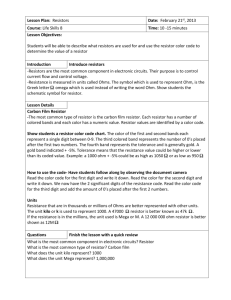Lab 4 Handout
advertisement
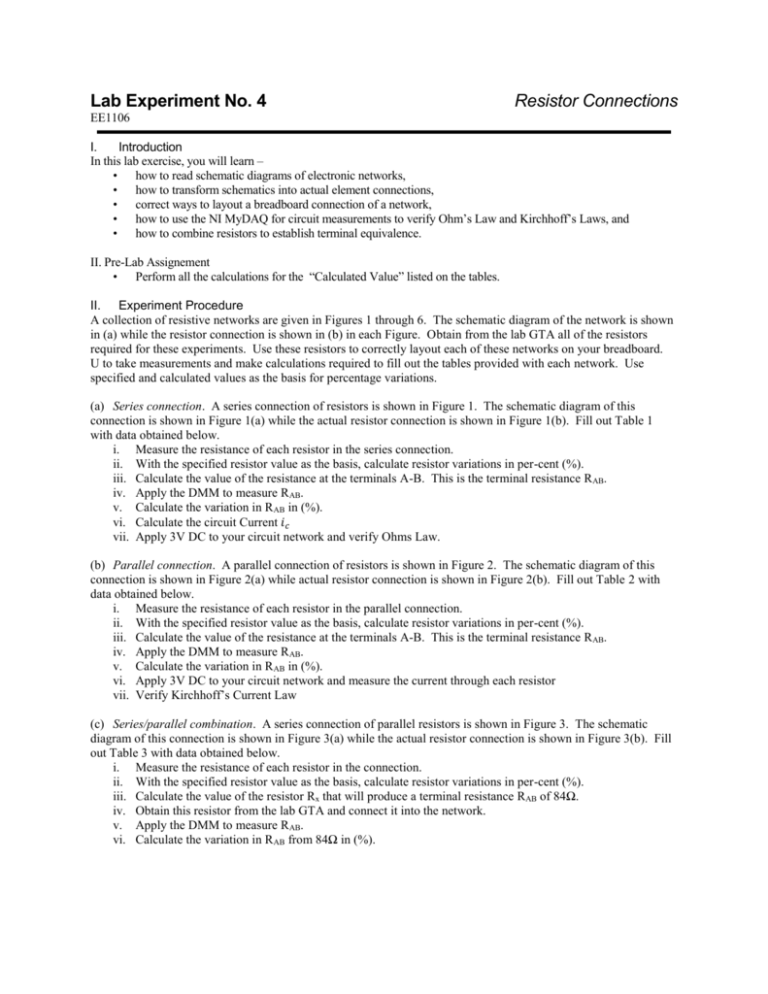
Lab Experiment No. 4 Resistor Connections EE1106 I. Introduction In this lab exercise, you will learn – • how to read schematic diagrams of electronic networks, • how to transform schematics into actual element connections, • correct ways to layout a breadboard connection of a network, • how to use the NI MyDAQ for circuit measurements to verify Ohm’s Law and Kirchhoff’s Laws, and • how to combine resistors to establish terminal equivalence. II. Pre-Lab Assignement • Perform all the calculations for the “Calculated Value” listed on the tables. II. Experiment Procedure A collection of resistive networks are given in Figures 1 through 6. The schematic diagram of the network is shown in (a) while the resistor connection is shown in (b) in each Figure. Obtain from the lab GTA all of the resistors required for these experiments. Use these resistors to correctly layout each of these networks on your breadboard. U to take measurements and make calculations required to fill out the tables provided with each network. Use specified and calculated values as the basis for percentage variations. (a) Series connection. A series connection of resistors is shown in Figure 1. The schematic diagram of this connection is shown in Figure 1(a) while the actual resistor connection is shown in Figure 1(b). Fill out Table 1 with data obtained below. i. Measure the resistance of each resistor in the series connection. ii. With the specified resistor value as the basis, calculate resistor variations in per-cent (%). iii. Calculate the value of the resistance at the terminals A-B. This is the terminal resistance RAB. iv. Apply the DMM to measure RAB. v. Calculate the variation in RAB in (%). vi. Calculate the circuit Current 𝑖𝑐 vii. Apply 3V DC to your circuit network and verify Ohms Law. (b) Parallel connection. A parallel connection of resistors is shown in Figure 2. The schematic diagram of this connection is shown in Figure 2(a) while actual resistor connection is shown in Figure 2(b). Fill out Table 2 with data obtained below. i. Measure the resistance of each resistor in the parallel connection. ii. With the specified resistor value as the basis, calculate resistor variations in per-cent (%). iii. Calculate the value of the resistance at the terminals A-B. This is the terminal resistance RAB. iv. Apply the DMM to measure RAB. v. Calculate the variation in RAB in (%). vi. Apply 3V DC to your circuit network and measure the current through each resistor vii. Verify Kirchhoff’s Current Law (c) Series/parallel combination. A series connection of parallel resistors is shown in Figure 3. The schematic diagram of this connection is shown in Figure 3(a) while the actual resistor connection is shown in Figure 3(b). Fill out Table 3 with data obtained below. i. Measure the resistance of each resistor in the connection. ii. With the specified resistor value as the basis, calculate resistor variations in per-cent (%). iii. Calculate the value of the resistor Rx that will produce a terminal resistance RAB of 84Ω. iv. Obtain this resistor from the lab GTA and connect it into the network. v. Apply the DMM to measure RAB. vi. Calculate the variation in RAB from 84Ω in (%). (d) Parallel/series combination. A parallel connection of series resistors is shown in Figure 4. The schematic diagram of this connection is shown in Figure 4(a) while the actual resistor connection is shown in Figure 4(b). Fill out Table 4 with data obtained below. i. Measure the resistance of each resistor in the connection. ii. With the specified resistor value as the basis, calculate resistor variations in per-cent (%). iii. Calculate the value of the resistor Rx that will produce a terminal resistance RAB of 1.83KΩ. iv. Obtain this resistor from the lab GTA and connect it into the network. v. Apply the DMM to measure RAB. vi. Calculate the variation in RAB from 1.42KΩ in (%). (e) Combination 1 (Combo 1) connection. A combination connection of resistors in series and parallel is shown in Figure 5. The schematic diagram of this connection is shown in Figure 5(a) while the actual resistor connection is shown in Figures 5(b). Fill out Table 5 with data obtained below. i. Measure the resistance of each resistor in the connection. ii. With the specified resistor value as the basis, calculate the resistor variation in per-cent (%). iii. Calculate the value of the resistance at the terminals A-B. This is the terminal resistance RAB. iv. Apply the DMM to measure RAB. v. Calculate the variation in RAB in (%). (f) Combination 2 (Combo 2) connection. Yet another combination connection of resistors in series and parallel is shown in Figure 6. The schematic diagram of this connection is shown in Figure 6(a) while the actual resistor connection is shown in Figures 6(b). Fill out Table 6 with data obtained below. i. Measure the resistance of each resistor in the connection. ii. With the specified resistor value as the basis, calculate the resistor variation in per-cent (%). iii. Calculate the value of the resistance at the terminals A-B. This is the terminal resistance RAB. iv. Apply the DMM to measure RAB. v. Calculate the variation in RAB in (%). III. Lab Report The report for this lab experiment must be word-processed and contain the following items – • Title Page. • Introduction. • Procedure. • Results. • Discussions. (a) Suggest useful applications for the connections studied in this experiment. • Conclusion. Provide detailed comments and discussions on the items listed below for each resistor network. (a) Are all resistors within tolerance? List those that are not. (b) Account for the difference between measured R AB and calculated RAB (that is, the calculated variation or tolerance of RAB). (c) Explain how the variation in RAB corresponds to resistor tolerance. (d) Explain how close the calculated values of Rx in the series/parallel and parallel/series connections are to standard resistor values. Consider resistor tolerance. • Appendix. • References. Series Connection 1 + R1 1 R2 2 A 3.9K 3V 2K 8.2K 5.1K R1 2 R2 RAB R3 1.2K B R5 A 3V R3 RAB - + 4 R4 3 - B R5 R4 3 4 (a) (b) Figure 1 (a) Schematic for the series connection (b) Component connection diagram Resistor Voltage 𝑉𝑅𝑖 (V) Table 1 Series connection Resistor (Ri) Specified value (Ω) Measured value (Ω) Variation (%) R1 3.9K R2 2K R3 5.1K R4 1.2K R5 8.2K Terminal resistance Calculated value (Ω) Measured value (Ω) Variation (%) Calculated Value (A) Measured Value (A) Variation (%) RAB Circuit Current 𝑖𝑐 Calculated (V) Measured (V) Parallel Connection + + A A 3V R1 R2 R4 R3 3V R5 RAB RAB 10K 7.5K 15K 3.3K R1 R2 R3 R4 R5 2.2K B - - B (a) (b) Figure 2 (a) Schematic for the parallel connection (b) Component connection diagram Table 2 Parallel connection Resistor (Ri) Specified value (Ω) R1 10K R2 7.5K R3 15K R4 3.3K R5 2.2K Terminal resistance Calculated value (Ω) RAB Measured value (Ω) Variation (%) Resistor Current 𝐼𝑅𝑖 (A) Calculated Measured (A) (A) Measured value (Ω) Variation (%) Terminal Current (A) Terminal Current (A) Series/Parallel Connection R6 R1 15 Rx A 2 R3 75 30 62 R4 R6 R3 R1 R7 3 1 A 12 27 82 R2 56 R8 RAB Rx R7 2 1 R2 R9 B (b) (a) Figure 3 (a) Schematic for the series/parallel connection (b) Component connection diagram Table 3 Series/parallel connection Resistor (Ri) Specified value (Ω) R1 15 R2 12 R3 30 R4 27 R5 56 R6 75 R7 62 R8 82 R9 91 Measured value (Ω) Variation (%) Measured value (Ω) Variation (%) Rx Terminal resistance Specified value (Ω) RAB 84 R8 R9 91 B 3 R5 RAB R5 R4 Parallel/Series Connection R6 R6 7.5K 4 R3 A R3 RAB B 3.0K 4 R1 A R1 Rx R2 1.5K 2 1 2.7K 5 3 8.2K R4 1.2K R7 2 R8 RAB 1 Rx 5.6K 5 R4 R2 R5 R7 6.2K 3 R8 6 B R9 9.1K 6 R5 R9 (a) (b) Figure 4 (a) Schematic for the parallel/series connection (b) Component connection diagram Table 4 Parallel/series connection Resistor (Ri) Specified value (Ω) R1 1.5K R2 1.2K R3 3K R4 2.7K R5 5.6K R6 7.5K R7 6.2K R8 8.2K R9 9.1K Measured value (Ω) Variation (%) Measured value (Ω) Variation (%) Rx Terminal resistance Specified value (Ω) RAB 1.83K Combo 1 Connection R1 R9 1 5 A 1.2K 200 R3 R4 R5 1.2K 3.6K R11 2 R15 6 R12 1.3K R6 RAB 1K 1.8K R13 1.5K 7 R8 2.2K 1.3K R14 1K 2.2K 300 B R2 4 R10 Figure 5 (a) Schematic for Combo 1 connection (b) Component connection diagram 8 9 3K 3 R7 2K R16 1K Table 5 Combo 1 connection Resistor (Ri) Specified value (Ω) R1 200 R2 1.3K R3 3.6K R4 1.2K R5 1.8K R6 1.3K R7 2.2K R8 2.2K R9 1.2K R10 300 R11 1K R12 1.5K R13 3K R14 1K R15 2K R16 1K Terminal resistance Calculated value (Ω) RAB Measured value (Ω) Variation (%) Measured value (Ω) Variation (%) Combo 2 connection R1 1 A 47K R2 R3 120K R9 10K 30K R13 R14 100K 2 4 RAB R4 R5 R10 30K 20K 7 R11 100K R15 300K 3 8 5 R6 R7 15K 15K 30K R12 15K R8 B 22K 6 Figure 6 (a) Schematic for Combo 2 connection (b) Component connection diagram R16 75K 150K Table 6 Combo 2 connection Resistor (Ri) Specified value (Ω) R1 47K R2 30K R3 120K R4 20K R5 30K R6 15K R7 30K R8 22K R9 10K R10 300K R11 100K R12 15K R13 100K R14 150K R15 15K R16 75K Terminal resistance Calculated value (Ω) RAB Measured value (Ω) Variation (%) Measured value (Ω) Variation (%)
